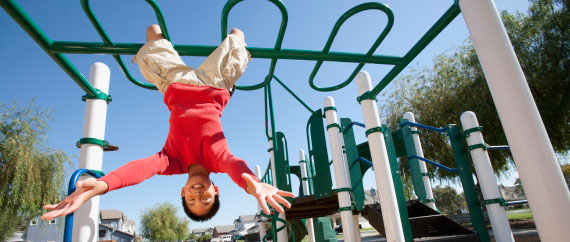Risky Play Essential for Child Development
As summer approaches and warmer temperatures arrive, you might expect to see kids actively, independently playing outdoors; but they aren’t. In fact, Canadian children spend over 7.5 hours a day being sedentary, while less than 9% of 5-17 year olds achieve the overall benchmark physical activity levels (at least 60 minutes of moderate-to-vigorous physical activity per day to achieve health benefits). These levels of activity gave Canadian children a D minus for activity in the 2015 ParticipACTION Report Card on Physical Activity for Children and Youth. They are also symptoms of a broader concern about children’s mobility. In fact, a recent article in a British newspaper showed how child mobility has changed in one family over four generations: from the 1920s, where an 8-year-old boy roamed up to 6 miles per day; to the 1960s, where his son-in-law was permitted to travel up to 1 mile from home on his own; to present day, where his great-grandson is allowed a 300-yard distance.
There are many reasons for this shrinking mobility, including perceptions of “stranger danger,” bullying and traffic, but these safety concerns appear to be largely unfounded as the odds of child abduction by a stranger are extremely rare (1 in 14 million), and children are 8 times more likely to be involved in a motor vehicle accident as a passenger than as a pedestrian.1 Overall, parental overprotection and societal attitudes that lean toward parental supervision have contributed to eliminating the active, independent, unstructured (risky) aspect of outdoor play. Yet, children need this type of play, as it contributes to their physical, emotional and psychological development which supports the skills necessary to thrive as adults. In fact, given their choices, kids willingly participate in many kinds of thrilling, exciting play, including play at speed, at heights, and with tools and sharp objects, as well as getting lost and rough-housing. These activities could cause injury, but kids have been shown to be good at self-regulating to protect themselves.
Another barrier to this type of play is the concern regarding playground injuries, with the resultant increased insurance liability costs and likelihood of being sued. These have led to increased safety measures and adult supervision, which limit children’s opportunities for risky outdoor play. While limiting playground injuries is an important component of children’s safety, children’s long-term health should be considered of greater importance. This notion has led to the development of a Canadian outdoor active play position statement which states that access to active play in nature and outdoors – with its risks – is essential for healthy child development, and that opportunities for self-directed play outdoors should be increased in all settings. This statement is based on the findings from a systematic literature review which indicated that the positive health effects of risky play outweighed the benefits of avoiding it.


